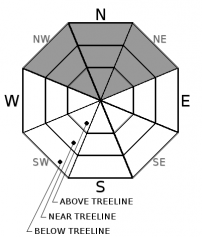| Thursday | Thursday Night | Friday | |
|---|---|---|---|
| Weather: | Sunny | Partly cloudy | Partly cloudy |
| Temperatures: | 51 to 56 deg. F. | 29 to 35 deg. F. | 53 to 58 deg. F. |
| Mid Slope Winds: | Southwest | Southwest | Southwest |
| Wind Speed: | Light in the morning increasing to 10 mph in the afternoon | 10 mph | 10 to 20 mph with gusts to 30 mph in the afternoon |
| Expected snowfall: | 0 | 0 | 0 |
| Thursday | Thursday Night | Friday | |
|---|---|---|---|
| Weather: | Sunny | Partly cloudy | Partly cloudy |
| Temperatures: | 48 to 54 deg. F. | 32 to 38 deg. F. | 50 to 56 deg. F. |
| Ridge Top Winds: | West | Southwest | Southwest |
| Wind Speed: | 10 to 20 mph with gusts to 30 mph in the afternoon | 15 to 25 mph with gusts to 40 mph | 20 to 35 mph with gusts to 50 mph in the morning increasing to 70 mph in the afternoon |
| Expected snowfall: | 0 | 0 | 0 |
























